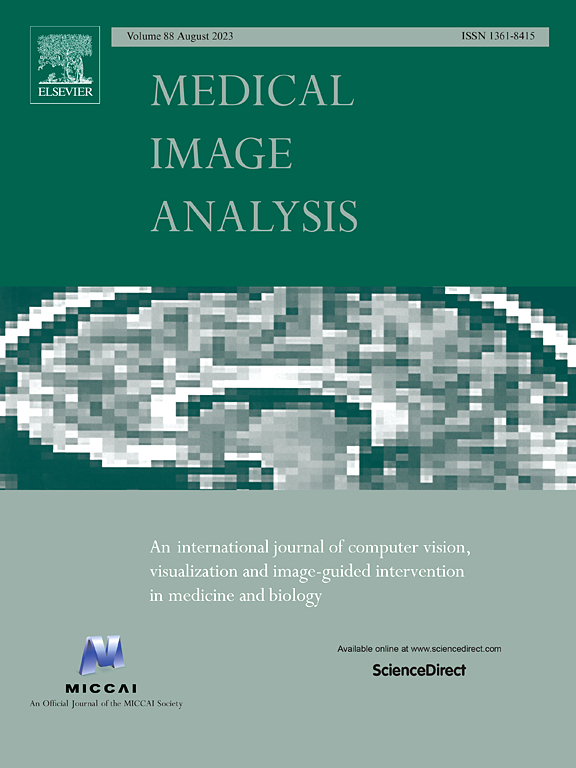IGUANe: A 3D generalizable CycleGAN for multicenter harmonization of brain MR images
IF 10.7
1区 医学
Q1 COMPUTER SCIENCE, ARTIFICIAL INTELLIGENCE
引用次数: 0
Abstract
In MRI studies, the aggregation of imaging data from multiple acquisition sites enhances sample size but may introduce site-related variabilities that hinder consistency in subsequent analyses. Deep learning methods for image translation have emerged as a solution for harmonizing MR images across sites. In this study, we introduce IGUANe (Image Generation with Unified Adversarial Networks), an original 3D model that leverages the strengths of domain translation and straightforward application of style transfer methods for multicenter brain MR image harmonization. IGUANe extends CycleGAN by integrating an arbitrary number of domains for training through a many-to-one architecture. The framework based on domain pairs enables the implementation of sampling strategies that prevent confusion between site-related and biological variabilities. During inference, the model can be applied to any image, even from an unknown acquisition site, making it a universal generator for harmonization. Trained on a dataset comprising T1-weighted images from 11 different scanners, IGUANe was evaluated on data from unseen sites. The assessments included the transformation of MR images with traveling subjects, the preservation of pairwise distances between MR images within domains, the evolution of volumetric patterns related to age and Alzheimer’s disease (AD), and the performance in age regression and patient classification tasks. Comparisons with other harmonization and normalization methods suggest that IGUANe better preserves individual information in MR images and is more suitable for maintaining and reinforcing variabilities related to age and AD. Future studies may further assess IGUANe in other multicenter contexts, either using the same model or retraining it for applications to different image modalities. Codes and the trained IGUANe model are available at https://github.com/RocaVincent/iguane_harmonization.git.

IGUANe:用于多中心协调脑磁共振图像的三维可通用 CycleGAN。
在核磁共振成像研究中,汇总来自多个采集点的成像数据可扩大样本量,但可能会引入与采集点相关的变异,从而妨碍后续分析的一致性。图像翻译的深度学习方法已成为协调各采集点磁共振图像的一种解决方案。在本研究中,我们引入了 IGUANe(用统一对抗网络生成图像),它是一种独创的三维模型,利用了领域翻译的优势和风格转换方法的直接应用,可用于多中心脑部 MR 图像协调。IGUANe 对 CycleGAN 进行了扩展,通过多对一架构整合了任意数量的域进行训练。基于域对的框架能够实施采样策略,防止混淆与部位相关的变异和生物变异。在推理过程中,该模型可应用于任何图像,甚至是来自未知采集地点的图像,从而使其成为一种通用的协调生成器。IGUANe 在由来自 11 个不同扫描仪的 T1 加权图像组成的数据集上进行了训练,并在来自未知部位的数据上进行了评估。评估内容包括磁共振图像与旅行对象的转换、域内磁共振图像之间成对距离的保持、与年龄和阿尔茨海默病(AD)相关的容积模式的演变,以及年龄回归和患者分类任务的性能。与其他协调和归一化方法的比较表明,IGUANe 能更好地保留 MR 图像中的个体信息,更适合保持和加强与年龄和 AD 相关的变异性。未来的研究可能会在其他多中心环境中进一步评估 IGUANe,或使用相同的模型,或对其进行重新训练以应用于不同的图像模式。代码和经过训练的 IGUANe 模型可在 https://github.com/RocaVincent/iguane_harmonization.git 网站上获取。
本文章由计算机程序翻译,如有差异,请以英文原文为准。
求助全文
约1分钟内获得全文
求助全文
来源期刊

Medical image analysis
工程技术-工程:生物医学
CiteScore
22.10
自引率
6.40%
发文量
309
审稿时长
6.6 months
期刊介绍:
Medical Image Analysis serves as a platform for sharing new research findings in the realm of medical and biological image analysis, with a focus on applications of computer vision, virtual reality, and robotics to biomedical imaging challenges. The journal prioritizes the publication of high-quality, original papers contributing to the fundamental science of processing, analyzing, and utilizing medical and biological images. It welcomes approaches utilizing biomedical image datasets across all spatial scales, from molecular/cellular imaging to tissue/organ imaging.
 求助内容:
求助内容: 应助结果提醒方式:
应助结果提醒方式:


